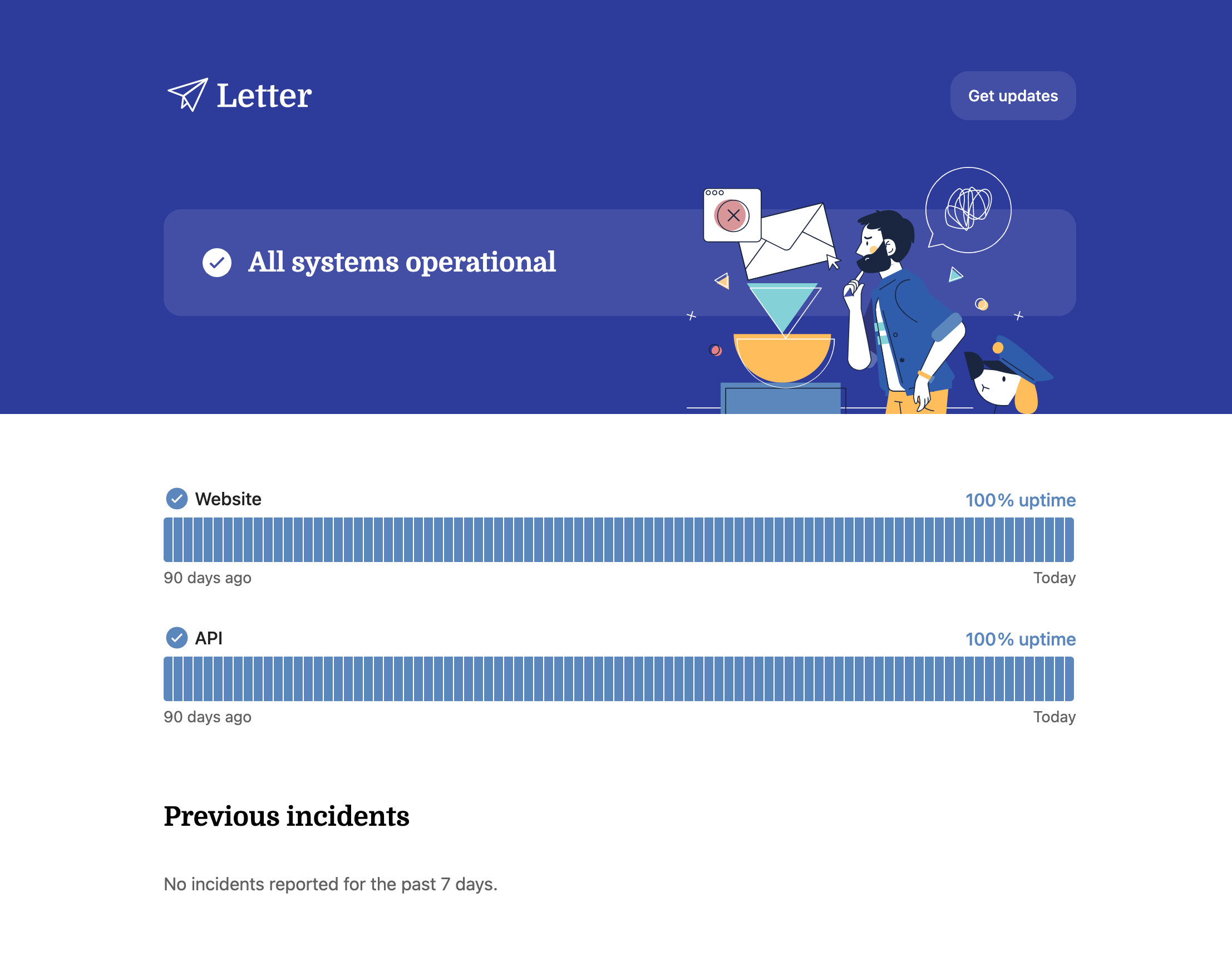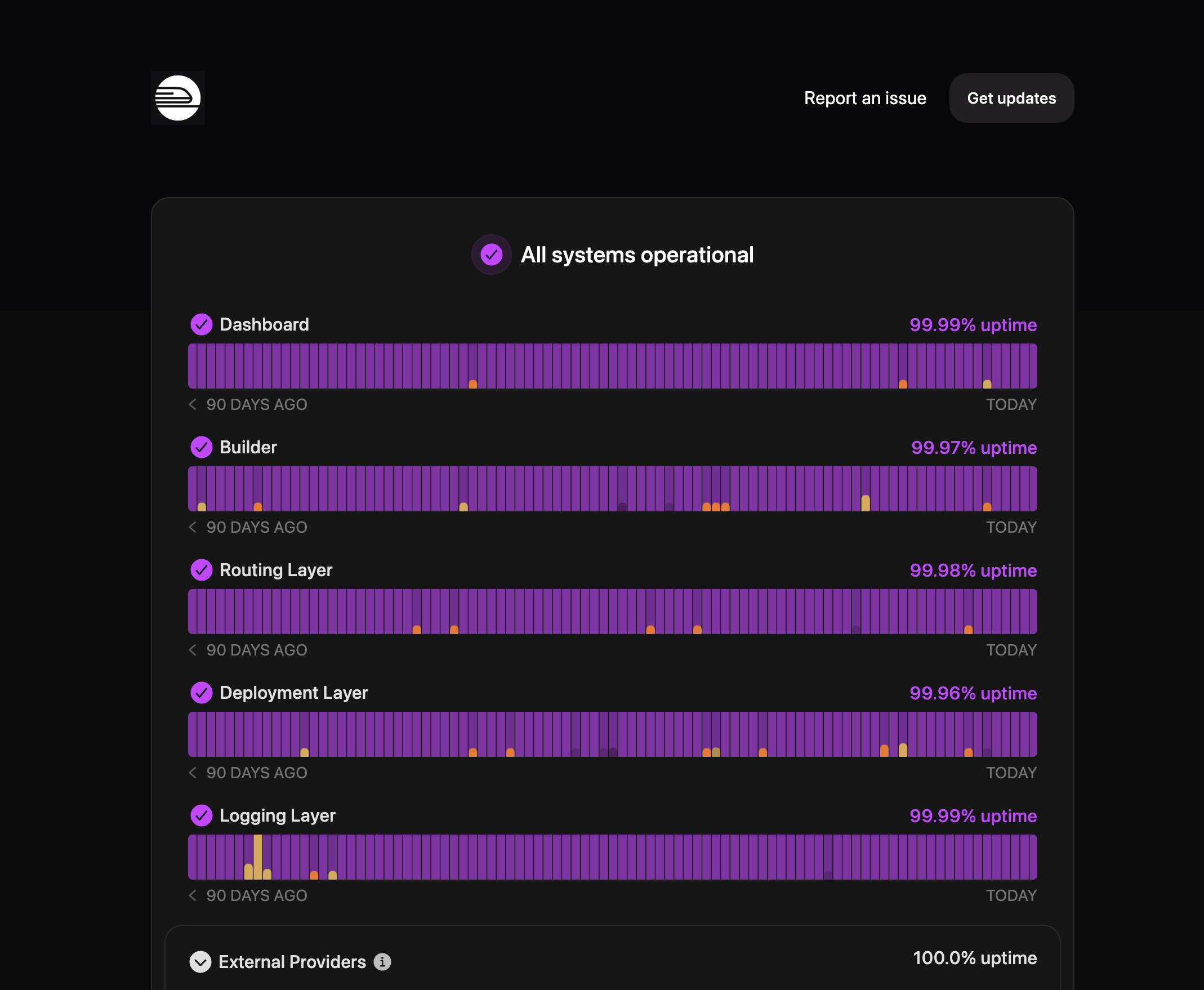Our 10-step guide on how to create an internal status page

Helpful summary
Overview: In this guide, we provide a 10-step process for creating an internal status page, emphasizing its role in monitoring system health and enhancing communication within organizations.
Why you can trust us: Our expertise is backed up by successful implementations, like the rapid setup of beautiful status pages for Deno, Podium, and Restream, improving their operational efficiency and transparency.
Why this is important: An internal status page is vital for real-time system monitoring, efficient incident response, and fostering a transparent, informed work environment.
Action points: Begin by defining objectives and choosing the right tools, like Instatus for cost-effective, customizable solutions, then focus on design, monitoring, and team training.
Further research: Explore integration options with monitoring tools and consider user feedback to continuously refine the status page's effectiveness.
Need help with creating an internal status page?
As for any organization offering its services or products online, maintaining operational efficiency and system reliability is important. However, one specific problem they typically encounter is the lack of real-time visibility into the health and performance of their internal systems. This problem can lead to increased downtime, reduced productivity, and a slower response to issues, which significantly impacts business operations.
Recognizing this challenge, Instatus offers a comprehensive solution designed to address this problem effectively. Our platform enables organizations to create and manage both public and private internal status pages easily, offering real-time updates about the status of their websites, applications, and other internal systems.
And, in this article, we’ll be outlining a step-by-step guide on how you can create your internal status pages, along with some best practices you should keep in mind.
Why listen to us?
At Instatus, we've empowered organizations like Philo, Restream, and Railway to monitor their website performance and craft internal status pages that beautifully inform their teams and customers of any issues. Our expertise in creating intuitive, customizable, and real-time status pages has proven essential for operational efficiency and transparency. We provide a user-friendly platform that simplifies the process of monitoring, tracking, and communicating system statuses, ensuring businesses stay informed and proactive.
What is an internal status page?
An internal status page is a webpage or dashboard used by an organization to monitor, track, and display the status of various internal systems, services, or operations. These pages are typically created using status page tools and are designed to provide real-time information about the health, performance, and availability of IT systems, networks, and applications.
Internal status pages can serve multiple purposes:
- Monitoring: They continuously check the status of different components and can show if systems are operating normally, experiencing issues, or are down for maintenance. This can include servers, databases, cloud services, and more.
- Alerting: They can notify relevant personnel (e.g., IT staff, developers) about issues, outages, or degradations in service. This helps in quickly identifying and addressing problems.
- Communication: They provide a central place for internal communication about the status of systems. This can be especially useful during incidents, where updates and estimated resolution times can be shared.
- Analysis: By tracking incidents and their resolutions, internal status pages can also aid in analyzing the reliability of systems over time, helping identify patterns or recurring issues that need attention.
At Instatus, we help users create and manage beautiful status pages. Our user-friendly platform enables organizations to set up both public and private status pages in just 10 seconds, simplifying the process of monitoring, tracking, and communicating the status of their systems or services. We also provide extensive customization options to align with your branding and communication needs.
Plus, our platform integrates with various monitoring tools and provides real-time alerts, ensuring that any issues are promptly identified and communicated to relevant personnel.
Why should you have an internal status page?
Having an internal status page is beneficial for organizations of all sizes for several reasons. These pages play a crucial role in maintaining operational efficiency, ensuring system reliability, and fostering transparency within the team.
Here are key reasons why you should consider having an internal status page:
Real-time visibility
Internal status pages provide real-time visibility into the health and performance of your systems and services. This immediate access to information helps in quickly identifying and addressing issues before they escalate, minimizing downtime and potential business impact.
Improved incident response
During outages or performance degradations, an internal status page serves as a centralized communication hub, similar to how an incident management tool works. It allows IT and support teams to update stakeholders on the issue, expected resolution time, and progress towards solving the problem, enhancing the organization's response to incidents.
Enhanced team collaboration
By keeping everyone informed about the status of internal tools and services, team members can better coordinate their efforts, especially in troubleshooting and resolving issues. This shared visibility helps prevent duplicated efforts and ensures that everyone is aligned on priorities and actions.
Increased productivity
Knowing the status of critical systems and services allows team members to plan their work more effectively. If a service is down, they can prioritize other tasks, reducing time wasted on trying to access unavailable resources.
Better decision making
Internal status pages often include historical data, metrics, and analytics on system performance and uptime. This information can be invaluable for making informed decisions about infrastructure improvements, resource allocation, and identifying areas that require additional investment or attention.
Trust and transparency
Providing teams with access to an internal status page fosters an environment of transparency. It shows a commitment to openness and trust, acknowledging that everyone is a stakeholder in the organization's operational health.
Compliance and audit trail
For organizations in regulated industries, maintaining an audit trail of system performance, incidents, and resolutions can be critical for compliance purposes. An internal status page can automatically log these events, simplifying compliance reporting and audits.
Steps on how to create an internal status page
Step 1: Define your objectives
Start by identifying key stakeholders and their needs, determining which services, systems, or components the status page will cover, and setting clear goals for what the page should achieve. This might include improving incident response times, enhancing communication within the team, or providing a real-time view of system health.
Step 2: Choose your tools and platform
Make a decision on whether to develop your status page in-house or use a self-hosted status pagelike Instatus, Cachet, or Uptime Kuma taking into consideration factors such as cost, customization, maintenance, and development time.
If cost is a concern, then Instatus is the perfect solution for you. We offer a flat-rate pricing that supports unlimited teammates, regardless of any plan you purchase, helping you scale without incurring additional charges.
Step 3: Design your status page
Design an interface that is intuitive and easy to navigate, with clear indicators for system health and inclusion of essential details such as current system status, scheduled maintenance, and incident reports. The design should also reflect your organization’s branding and communication style for consistency.
With Instatus, you can create a beautiful status page in just 10 seconds! You can even personalize your status page to match your branding and style. Change the brand colors, logos, domain settings, and appearance as you like to maintain consistency with your brand’s identity.
Step 4: Set up monitoring and alerts
Integrate with monitoring tools to automatically update the status of services in real time and implement alerting mechanisms to notify responsible team members when a system's status changes. This setup is crucial for prompt incident response and system maintenance.

At Instatus, our platform seamlessly integrates with your favorite monitoring tools such as Freshping, Site24x7, and Pagerduty so you can manage all your existing systems in just one place.
Step 5: Develop incident communication protocols
Establish clear procedures and incident management strategies for reporting incidents on the status page, including defining roles and responsibilities for updates during incidents, and creating templates or guidelines for communication to ensure consistency and clarity in messages.
Step 6: Implement access controls
Ensure that only authorized personnel can view and edit the status page by setting up secure access controls. This step is important for protecting sensitive information and complying with privacy regulations.
Step 7: Test your status page
Conduct thorough testing of all components of the status page, including real-time updates, alerts, and access controls, to ensure everything works as expected. Load testing is also important to ensure the page can handle high traffic volumes during major incidents.
Step 8: Train your team
Educate your team on how to use the status page effectively, including updating statuses and communicating during incidents. It's also vital to raise awareness about access controls and privacy considerations.
Step 9: Launch and communicate
Launch the status page with a clear internal announcement outlining its purpose and guidelines for use. Establishing a feedback loop with users is crucial for identifying areas for improvement and ensuring the page meets the needs of your organization.
Step 10: Maintain and update
Regularly review the status page to ensure it remains accurate, relevant, and user-friendly. Keep it updated with any new services, features, or changes in your IT infrastructure to maintain its effectiveness as a communication tool.
Best practices when creating an internal status page
Clear and concise information
Ensure the information on the status page is clear, concise, and easily understandable. Use simple language and avoid technical jargon that may confuse non-technical team members. Clearly define what each status means (e.g., operational, maintenance, outage) and use consistent color codes or symbols for quick recognition.
Real-time updates
Implement real-time monitoring and updating mechanisms to reflect the current status of systems and services accurately. This helps in quickly identifying and addressing issues, reducing the impact of downtimes.
Comprehensive coverage
Cover all critical systems, services, and components that affect your organization's operations. This includes not just IT infrastructure but any service that, if disrupted, could impact business processes or productivity.
Security and privacy
Given the sensitivity of the information displayed, ensure that the status page is secure and accessible only to authorized personnel. Implement strong access controls and authentication measures to protect against unauthorized access.
Incident history and transparency
Maintain a log of past incidents, including the issue, its duration, and the resolution. This history is valuable for reviewing performance over time of your internal status page and demonstrating transparency and accountability to your team.
Actionable guidance
Provide guidance or action items for users during incidents. This could include workarounds, who to contact for more information, or steps being taken to resolve the issue. This helps reduce confusion and allows team members to adjust their work plans accordingly.
User-friendly design
Design the status page to be intuitive and easy to navigate, ensuring that users can quickly find the information they need. Mobile responsiveness is also crucial, as team members may need to access the page from various devices.
Feedback mechanism
Incorporate a mechanism for users to provide feedback on the status page. This can help identify areas for improvement and ensure the page continues to meet the needs of your organization.
Get the most out of your status pages with Instatus!
Creating an internal status page is a smart move for any organization looking to enhance operational efficiency, incident response, and internal communication. By following the 10-step guide outlined in this article, you can set up a status page that provides real-time visibility into your site’s system health, improves collaboration among team members, and aids in making informed decisions.
If you're ready to take the next step in operational transparency and efficiency, consider Instatus for your internal status page needs. Our platform is designed to be user-friendly, customizable, and integrates with a variety of monitoring tools to keep your team informed and ready to respond to any incidents.
Get started today and empower your team with the tools they need to succeed.
Get ready for downtime
Monitor your services
Fix incidents with your team
Share your status with customers





